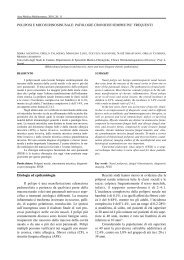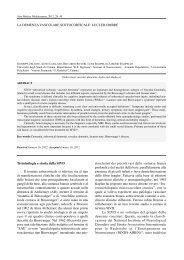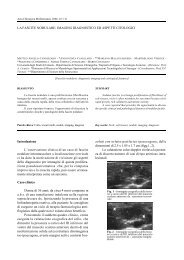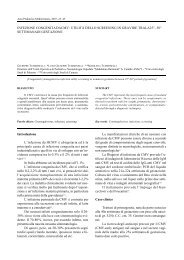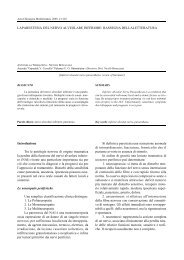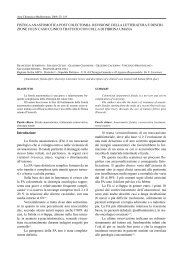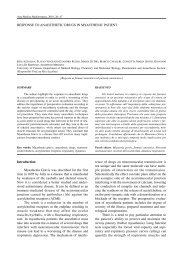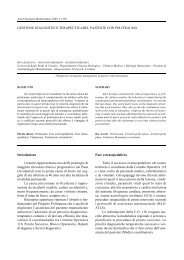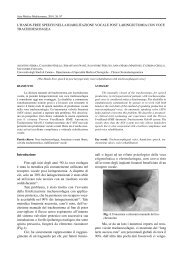Acta Chirurgica Mediterranea, 2009, 25: 29 '- G - F - Carbone Editore
Acta Chirurgica Mediterranea, 2009, 25: 29 '- G - F - Carbone Editore
Acta Chirurgica Mediterranea, 2009, 25: 29 '- G - F - Carbone Editore
Create successful ePaper yourself
Turn your PDF publications into a flip-book with our unique Google optimized e-Paper software.
<strong>Acta</strong> <strong>Chirurgica</strong> <strong>Mediterranea</strong>, <strong>2009</strong>, <strong>25</strong>: <strong>29</strong><br />
TRABUCCO’S TECHNIQUE IN THE TREATMENT OF INGUINAL HERNIA: TEN-YEAR EXPERIENCE<br />
GIUSEPPE VADALA’- GIUSEPPINA SANGANI - FILIPPO MUGAVERO - FLAVIA GENTILE - SALVATORE VADALA’<br />
University of Catania - II Chair of Emergency Surgery and P. S. (Head: Prof. G. Vadalà)<br />
SUMMARY<br />
Treatment of inguinal hernia is actually based on the use<br />
of synthetic prothesis. The “tension free technique” of<br />
Lichtenstein and Trabucco represents a gold standard in this<br />
pathology.<br />
The present study demonstrates how the “tension free<br />
technique”, idealized by Lichtenstein, and then modified by<br />
Trabucco is a good treatment than the laparoscopic one.<br />
The A.A. review their experience, from January 2000 to<br />
July 2008; during this period, at the II Chair of Emergency<br />
Surgery University of Catania, they have treated for inguinal<br />
hernia 122 patients. They have performed the hernioplasty with<br />
a “tension free technique” ideated by Lichtestein, and then<br />
modified by Trabucco.<br />
Morbility was only 1%, no mortality.<br />
The Authors think so that the technique adopted is<br />
safety, not expensive and when it is possible, actuated in day<br />
surgery by the use of local anesthesia.<br />
Key words: Inguinal hernia, hernioplasty, tension free technique<br />
Introduction<br />
[Il trattamento dell’ernia inguinale secondo la tecnica di Trabucco: nostra esperienza decennale]<br />
Hernia disease represent about 70% of the<br />
pathology of the abdominal wall.<br />
In Italy the incidence is approximately 15<br />
cases for 1,000 inhabitants, equal to 1, 5%. There is<br />
a clear predominance of males in the presentation<br />
than females (5 to 10:1).<br />
The intervention of hernioplasty is, in fact, the<br />
most frequently performed in the departments of<br />
general surgery (15% of total).<br />
RIASSUNTO<br />
Il trattamento dell’ernia inguinale verte attualmente sull’utilizzo<br />
delle protesi. Le metodiche “tension free” di Lichtenstein<br />
prima e di Trabucco poi, con le loro varianti, rappresentano<br />
oggigiorno un punto fermo per la chirurgia erniaria (1) .<br />
Abbiamo analizzato retrospettivamente la nostra esperienza<br />
comprendente il periodo gennaio 2000- luglio 2008,<br />
durante il quale, presso la II Cattedra di Chirurgia D’Urgenza<br />
e Pronto Soccorso, sono stati sottoposti ad intervento chirurgico<br />
per ernia inguinale 122 pazienti. In tutti i pazienti abbiamo<br />
utilizzato l’intervento di alloplastica secondo le metodiche “tension<br />
free”, ideato da Lichtenstein e poi modificato da<br />
Trabucco (2) . La percentuale di recidive pervenute alla nostra<br />
osservazione fino al luglio 2008 è stata dell'1% (1 solo caso). In<br />
6 casi (4,9%) si sono rilevate complicanze minori.<br />
Ambedue le metodiche sembrano pertanto rispondere in<br />
maniera ottimale a criteri di sicurezza, efficacia e limitato costo<br />
socio-economico, nonché la possibilità di conduzione in anestesia<br />
locale dell’intervento<br />
Risulta pertanto molto discutibile il tentativo, secondo la<br />
nostra esperienza, di allargare anche all’ernia le indicazioni<br />
della “chirurgia laparoscopica” o mini-invasiva. In questa tipologia<br />
di intervento infatti la tecnica è certamente più complessa,<br />
costosa e sicuramente molto più aggressiva rispetto alla chirurgia<br />
aperta.<br />
Parole chiave: Ernia inguinale, ernioplastica, tecnica tension<br />
free<br />
Material and methods<br />
In the period between January 1998 and July<br />
2008, at the II Chair of Emergency Surgery and<br />
First Aid of Catania University, 122 patients were<br />
treated for inguinal hernia disease.<br />
The average age was 52 years (range 10-84<br />
years); in all patients it was used the intervention<br />
of halloplastic according to "tension free technique”,<br />
performed by Lichtenstein and then modified<br />
by Trabucco (2) (fig.1, 2).
30 G. Vadalà - G. Sangani et Al<br />
Trabucco Hernia Institute<br />
<strong>29</strong>-22 30th AVE. New York, NY<br />
Ermanno E. Trabucco M.D.<br />
Fig. II: Plano of positioning<br />
mesh.<br />
Fig. I: Text about<br />
Trabucco’s technique.<br />
In most cases it is used the local anesthesia or<br />
under specific conditions, if required by the patient,<br />
spinal or general anesthesia.<br />
The intervention was carried out always following<br />
the technique described by Trabucco. The average<br />
duration was 55 minutes. The main points are:<br />
• a singular administration of a cephalosporin<br />
immediately before the intervention (short term<br />
therapy);<br />
• Infiltration for anatomical plans, step by<br />
step, of structures with an average use of 40 cc of<br />
anesthetic solution of Carbocaina, this method facilitates<br />
the preparation of anatomical, exploiting the<br />
effect of “hydrodissection” due to the anesthetic<br />
mixture;<br />
• Transverse para-inguinal skin incision, of<br />
about 10 cm;<br />
• Opening of the external oblique muscle aponeurosis,<br />
after sub fascial infiltration of about 3 ml.<br />
of carbocaina in order to anesthetize and isolate ileo<br />
inguinal and ileo ipogastric nerves;<br />
• Opening of the external inguinal ring and<br />
dissection of the elements contained in the channel<br />
(deferential duct and sperm vessels);<br />
• Isolation of the hernia, that can be closed,<br />
opened or resected; positioning, in the internal<br />
inguinal ring, of a “plug” conformed to cigarette<br />
and folded “V” this is possible to be fixed, to prevent<br />
migration, between internal oblique-transverse<br />
muscle and inguinal ligament;<br />
• Use of a polypropylene mesh cut for the passage<br />
of the spermatic funicle and its components;<br />
• It is possible to fix the mesh to the pubic<br />
tubercle, to the Poopart’s ligament and to the external<br />
oblique muscle fascia after closing the tails<br />
behind the passage of the funicular;<br />
• Closure of the fascia of the external oblique<br />
muscle with two semi continuous suture of non<br />
absorbable material (prolene 3 / 0);<br />
• Closure of the skin with intradermic suture<br />
or with metal clips.<br />
Of the 122 patients with inguinal hernia operated<br />
by the “tension free” technique according to<br />
Trabucco, only 1 patient presented a relapse in the<br />
subsequent two years: the relapse at the tubercle of<br />
the pubis was caused by a too small mesh and by a<br />
not concomitant treatment of direct hernia.<br />
No major intra-and post-operative complication<br />
occurred.<br />
In 6 cases (4.9%) minor complications were<br />
detected as follows: 4 patients had a sieroma, 2 an<br />
hematoma. In each case, the resolution is achieved<br />
by drainage, without removing the mesh.<br />
Postoperative pain was easily controlled with<br />
Ketorolac 30 mg fl/im.<br />
The functional recovery was very rapid (24<br />
hours average) for all patients. The average postoperative<br />
hospital stay was between 1 and 5 days. The<br />
follow-up was performed from 6 months to 5 years<br />
without signs of note, and no hernia recurrence.<br />
The percentage of recurrences was 1% of<br />
cases. This result appears contrary to that described<br />
in the literature for the method of Bassini which<br />
give 15-20% of recurrences, even if they were reduced<br />
with the changes made by Postemsky and Mac<br />
Vay.<br />
Discussion<br />
The first codified treatment for hernia disease<br />
was described by Bassini, in 1884 (3,4) .<br />
Until some years ago, this technique has been<br />
used from many surgeons (5, 6) .<br />
In 1983 Madden published a masterly on the<br />
hernia surgery, reaffirming the validity of Bassini’s<br />
method.
Trabucco’s technique in the treatment of Inguinal Hernia: ten-year experience 31<br />
The complications secondary to this method<br />
(high incidence of recurrence) were due to the<br />
increase in tissue’s tension with consequent instability<br />
of the sutures, had brought, in the last years, to<br />
search alternative technique “tension free” as<br />
McVay, Postemsky, Shouldice (4, 7) .<br />
The real revolution came in 1974 with the studies<br />
of Lichtenstein (9,10, 1) about synthetic materials<br />
(mersylene, polypropylene, etc..) and their routine use<br />
as prosthetic material. These materials with which<br />
meshes were made given at first time many reactions<br />
(rejection even after years), that limited their use.<br />
Some French Authors had realize the importance<br />
of the “biologically inert” materials so “steel<br />
meshes”, but their use had many limitations related<br />
to the low ductility of the material and the considerable<br />
inconvenience caused by his visible presence.<br />
Lichtenstein performed a correction of the hernia<br />
defect, under local anesthesia, through the use of<br />
a polypropylene mesh, that allowed a “tension free”<br />
reconstruction of the integrity of the posterior wall<br />
of the inguinal canal (12) . The results were excellent in<br />
terms of compliance, of effectiveness and of morbility<br />
near and far (1-2% of recurrence) and of socioeconomic<br />
aspects. These results are been accepted<br />
by entire scientific world (13,14,15,16) .<br />
Other studies have proposed some variations,<br />
especially relate to the kind of the mesh , to the seat<br />
of his positioning, the type of approach (front or<br />
rear), and the type of anesthesia (17) .<br />
The real innovations were introduced by<br />
Trabucco in 1993, who codified a “tension free” and<br />
“sutureless” hernioplastic (18) which included the use<br />
of a “plug” to fill the defect of the posterior wall of<br />
inguinal canal (2:15). Others A.A. (Stoppa, Rives<br />
etc..) proposed the correction with posterior approach,<br />
were little used because of not satisfying the<br />
needs of minor surgical possible “pollution”.<br />
The surgeon has a choice of treatment options<br />
based on the concept of repair with biomaterials, the<br />
choice between each of them must be guided and<br />
influenced only by the personal experience, since<br />
the effectiveness of each is substantially similar to<br />
the others.<br />
The incidence rate of recurrence with “plug<br />
and mesh method is around 0.5-1% of cases, as in<br />
our experience (2,15) . The ideal surgical procedure is<br />
the technique that combines simplicity with maximum<br />
efficiency.<br />
The use of local anesthesia and the “day surgery”<br />
recovery have an additional element of pleasure<br />
for the patient.<br />
The routine use of prosthetic material has brought<br />
to the total delate of Bassini Postemsky Mac<br />
Vay technique. Methods, first described by<br />
Lichtenstein and then by Trabucco, seem to respond<br />
optimally to the criterions of safety, effectiveness<br />
and limited socio-economical cost.<br />
The only case of a recurrence complained, in<br />
our experience, was due to the failure of the methodology<br />
adopted by us. The mesh used was, in fact,<br />
too small, and didn’t overlap the pubic tubercle.<br />
Trabucco with his concept of “tension free”<br />
plastic, using routinely the plug, have helped to<br />
alleviate recurrences secondary to wall’s collapse.<br />
We use simplex or standard mesh because sometimes<br />
we want to adapt the prothesis to the patient<br />
and not viceversa. Plug’s shape, formed a “V”,<br />
reflects the need to bridge inguinal orifice in an elastic<br />
way without leaving empty spaces. The medial<br />
section of the mesh is useful to the passage of the<br />
funicle without creating areas of weakness and eliminating<br />
the possibility of “guillotine” effect exercised<br />
by the thermal-induced retraction in time.<br />
Considering that among the most feared complications,<br />
prosthesis’s infection is the more<br />
worrying, because it is cause of relapse and septic<br />
issues both local and generalized, some AA, in order<br />
to prevent infection, use a powder of clindamycin or<br />
chemicetina over the mesh, in order to avoiding<br />
responding bacterial prosthetic infection.<br />
“Staphylococcus epidermidis” is in particular (16,<br />
17) , the principle agent of prosthetic sepsis, but, in<br />
general, all the Coag-negative germs generate a glicocalix<br />
(18) , that is a mucosal extracellular substance<br />
extracellular essentially composed of 70% by N-<br />
Acetyl-Glucosamine, and that cements the bacteria<br />
to the prosthesis, creating a barrier to antibiotic penetration.<br />
It thus prevents bacterial colonization, the<br />
first step in the chronic infection of the prosthesis.<br />
Anesthetic infiltration for plans allows a slow<br />
release of anesthetic (20 cc of mepivacaina, 10 cc of<br />
bupivacaina, 20cc of saline and 5 cc of sodium<br />
bicarbonate), and an hydro dissection of the anatomical<br />
structures with good and rapid intervention<br />
conduction. Some A.A. use a gel (Emla), which<br />
when applied well in advance on the skin, provides<br />
excellent pre-and postoperative analgesia.<br />
About External oblique hernias, the technical<br />
changes concern both the plug, both the mesh (19 ).<br />
The plug of polypropylene folded “V”, positioned in<br />
the internal inguinal ring, is fixed with two points:<br />
in this way it retains its function as a stopper, however,<br />
ensuring flexibility and ductility to the structure.
32 G. Vadalà - G. Sangani et Al<br />
The mesh, which is also made of polypropylene,<br />
is modeled to cover the pubis and below the<br />
large muscles medially and superiorly, with side<br />
access to the funicle. We prefer a single sheet rather<br />
than a double because it may cause mechanical prosthetic<br />
infection or give pain. When possible, it must<br />
reconstruct the Cremaster fascia that provides additional<br />
protection to the internal inguinal ring.<br />
In direct hernias, the positioning of the mesh<br />
and the opening is preceded by the anchoring of the<br />
trasversalis fascia that allows optimal distension of<br />
the prothesis.<br />
The opening of trasversalis muscle fascia and<br />
of transverse abdominal muscle aponeurosis, around<br />
the herniary protrusion, promotes fibroblast proliferation.<br />
Conclusions<br />
The modern treatment of herniary disease was<br />
born with the advent of biocompatible prothesis.<br />
“Tension free” methods by Lichtenstein at first,<br />
and then Trabucco, with their variations, are now<br />
accepted for the treatment of herniary surgery (1) .<br />
Both respond optimally to the criteria of safety,<br />
effectiveness and not expensive.<br />
The possibility to conduct operation under<br />
local anesthesia has contributed to the spread of<br />
“day surgery” treatment.<br />
We can conclude, in accord with the results<br />
from our experience, comforted by the international<br />
literature, that the “tension-free” technique by<br />
Trabucco can be considered the gold standard for<br />
the treatment of inguinal hernia.<br />
Bibliography<br />
1) Negro P, Gossetti F, D’Amore L, Proposito D, Vermeil<br />
V, Battillocchi B et al.: “1000 Ernioplastiche protesiche:<br />
esperienze di un gruppo dedicato”. Chirurgia It<br />
2000; 52:3: 279-88.<br />
2) Trabucco E., Trabucco A., Rollino R., Morino M.:<br />
“L’ernioplastica inguinale tension-free con rete presagomata<br />
senza suture secondo Trabucco”. Chirurgia;<br />
2:1-7, 1998.<br />
3) Bassini E.: “Nuovo metodo operativo per la cura radicale<br />
dell'ernia inguinale”. R. Stabilimento Prosperin<br />
Padova, 1889.<br />
4) DesCoteaux J.G.: “Inguinal hernia repair: a survey of<br />
Canadian practice patterns”. CJS; 42 (2): 127-132,<br />
1999.<br />
5) Wantz G.E.: “The operation of Bassini as described by<br />
A. Catterina”. Surg Gynecol Obstet; 168:67-80, 1989.<br />
6) Wantz G.E.: “Ambulatory hernia surgery”. Br J Surg; 76<br />
(21): 118-<strong>29</strong>, 1989.<br />
7) Shouldice E.F.: “The treatment of hernia”. Ontar Med<br />
Rev; 1: 14, 1953.<br />
8) Bendavid R.: “The Shouldice method of inguinal<br />
Herniorraphy”. In: Nyus LM. Baker RJ. Editors. Master<br />
of Surgery second edition. Boston. 1584-94, 1992.<br />
9) Mc Vay C.B.: “The anatomical basis for inguinal and<br />
femoral herniorraplasty”. Surg Gynecol Obstet;<br />
139:931-45, 1974.<br />
10) Lichtenstein I.L., Shore jm: “Simplified repair of femoral<br />
and recurrent inguinal hernia by a “Plug” technique”.<br />
Ann J Surg, 128: 439-441, 1994.<br />
11) Lichtenstein I.L., Shulman A.G.: “Ambulatory outpatient<br />
surgery”. Int Surg, 71: 1-3, 1986.<br />
12) Amid P.K.: “Classification of biomaterials and their<br />
related complications in abdominal wall hernia<br />
surgery”. Hernia 1997; 1:15-21.<br />
13) Bellone D.: “L’ernioplastica “tension free”. Nostra<br />
esperienza”. Minerva Chir; 54: 123-5, 1999.<br />
14) Campanelli G.P. et al.: “Ernioplastica sec. Trabucco”.<br />
Chirurgia; 7: 228-31, 1994.<br />
15) Trabucco E.: “The office hernioplasty and the Trabucco<br />
repair”. Ann It Chir; 64: 127-49, 1993.<br />
16) Perez Giraldo C. et al.: “Influence of N-acetylcisteine on<br />
the formation of biofilm by S. epidermidis”. J.<br />
Antimicrob Chemother 39: 643-6; 1997.<br />
17) Farber B.F., Kaplan M.N., et al.: “S epidermidis extracted<br />
slime inhibits the antimicrobial action of glycopeptide<br />
antibiotics”. J Infect Dis 161: 37-40; 1990.<br />
18) Concia E.: “Il glicocalice quale fattore di patogenicità<br />
nelle infezioni da corpo estraneo”. Edimes Pavia, 1990.<br />
19) Kingsnorth A, LeBlanc K.: “Hernias: inguinal and<br />
Incisional”. Lancet 2003; 362: 1561-71.<br />
_________<br />
Request reprints from:<br />
Prof. GIUSEPPE VADALÀ<br />
Via Aloisio 20<br />
95124 Catania<br />
(Italy)



